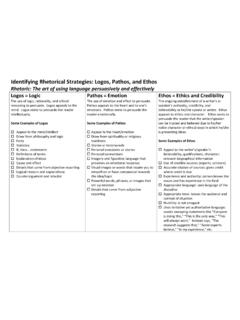Transcription of Crisis (hostage) negotiation: current strategies and ...
1 Crisis ( hostage ) negotiation: current strategies and issues inhigh-risk conflict resolutionGregory M. Vecchia,*, Vincent B. Van Hasseltb, Stephen J. RomanocaCrisis Negotiation Unit, Federal Bureau of Investigation, FBI Academy, United StatesbCenter for Psychological Studies, Nova Southeastern University, United StatescCrisis and Security Management, Control Risks Group, Washington, DC, United StatesReceived 24 August 2003; received in revised form 14 September 2004; accepted 4 October 2004 AbstractCrisis ( hostage ) negotiation has been described as the most significant development in lawenforcement and police psychology over the past several decades. This paper reviews three primarycomponents of Crisis negotiation: (1) the incorporation of Crisis management and intervention incurrent broad-spectrum approaches to Crisis negotiation; (2) the Behavioral Change Stairway Model(BCSM), constructed by the Federal Bureau of Investigation s (FBI) Crisis Negotiation Unit (CNU),that provides a systematic, multistep process directed toward peaceful, nonlethal resolution of criticalincidents; and (3) role-playing as a vital tool in the assessment and training of Crisis negotiation and limitations in the field of Crisis negotiation are highlighted; suggestions fordirections that future work in this area might take are Elsevier Ltd.
2 All rights : Crisis negotiation; hostage negotiation; Crisis intervention; Role-playing; Conflict resolution; Online1359-1789/$ - see front matterD2004 Elsevier Ltd. All rights * Corresponding author. Tel.: +1 540 809 ( Vecchi).Aggression and Violent Behavior 10 (2005) 533 551 Contents1. Overview and hostage vs. non- hostage Tactical vs. negotiated 5362. Crises: states, stages, and The Crisis Crisis Goals of Crisis Establishing communication and developing Buying Defusing intense Gathering Crisis intervention Dealing with Establishing Identifying the precipitating event(s).. Problem 5403. Behavioral change stairway Stage 1: active Core active listening Supplemental active listening Stage 2: Stage 3: Stage 4: Stage 5: behavioral 5454. Role-play Negotiation skills 5475.
3 Summary and future 550 Law enforcement agencies have been employing negotiation strategies in their responses tohostage/barricade situations, kidnappings, personal crises, and other critical incidents sincethey were first introduced by the New York City Police Department in 1973. This trendfollowed the debacle of the 1971 Attica, New York prison riot, and the murder of Israeli athletesduring the 1972 Olympic Games in Munich, Germany. Since that time, several models ofnegotiation have been developed for use in hostage situations, based primarily on problem-solving approaches to response, management, and resolution of these incidents (Fisher, Ury, &Patton, 1991; Lanceley, 1999; McMains & Mullins, 2001; Webster, 1998a). However, problem-solving strategies have proven effective only subsequent to addressing and defusing thesubject s emotional state; and this appears true regardless of the situation (Noesner & Webster,1997; Rogan, Hammer, & Van Zandt, 1997; Romano & McMann, 1997).
4 Vecchi et al. / Aggression and Violent Behavior 10 (2005) 533 551534 This paper discusses current strategies in Crisis ( hostage ) negotiation that have beendeveloped and implemented to facilitate: (a) the transition of a hostage or non-hostagecritical incident from a state of high emotionality ( Crisis ) to rationality (problem solving),and (b) the eventual peaceful or nonlethal resolution of the Crisis situation. Following anoverview and definition of key terms, we review three primary components of the crisisnegotiation process: (1) Crisis management and intervention in the context of criticalincidents, (2) the Behavioral Change Stairway Model for achieving conflict resolution,and (3) utilization of role-play procedures to train requisite Crisis negotiation Overview and definitionsPolice organizations have historically emphasized problem-solving training for theirnegotiators. Illustrative are the four tenants ofFisher s et al. (1991)negotiation model thathave enjoyed widespread application in this area: (1) separate the person from the problem,(2) focus on his or her interests rather than positions, (3) generate options, and (4) establishclear objective criteria for behavioral change.
5 For years, this model was adopted for hostagenegotiation by law enforcement organizations across the nation (seeMcMains & Mullins,2001).Even the Federal Bureau of Investigation (FBI) focused on problem-solving strategiesfor negotiators until 2000. At that time, the FBI Crisis Negotiation Unit (CNU), atthe FBI Academy in Quantico, Virginia, conducted research that illustrated the needfor change and modification of the curriculum for their National Crisis NegotiationCourse (NCNC). Their work examined data from the CNU s hostage Barricade DatabaseSystem (HOBAS). HOBAS is a post-incident database that collects and stores caseinformation from law enforcement agencies nationwide and now contains over 3800hostage/barricade incidents. Their research revealed that over 90% of all reported criticalincidents were, in fact, non- hostage , Crisis situations (Flood, 2003). Consequently, theNCNC curriculum was modified to emphasize a broader range ofcrisis interventionstrategies and hostage vs.
6 Non- hostage situationsConsiderable confusion currently exists regarding the differences between hostage andnon- hostage situationsinvolve the taking of a person captive forbinstrumentalQor tangible reasons; the suspect needs the police or other authorities to meetspecific demands ( , ransom, transportation, money). In these events, the captive is usedas leverage to obtain other substantive goals. For example, foreign nationals holding prisonguards captive in exchange for the release of political prisoners, money, and transportationwould constitute an actual hostage situation. In anon- hostage situation, a person is takencaptive forbexpressiveQor intangible reasons; he or she does not need the police or otherauthorities. In these situations, the captive is held by a subject who is in a highly emotionalstate ( , anger, jealousy, frustration), usually as a victim orbhomicide-to-beQ. Vecchi et al. / Aggression and Violent Behavior 10 (2005) 533 551535of these scenarios are: holding one s spouse captive as a result of an extramarital affair, andrejection due to an impending separation or divorce (Van Hasselt et al.)
7 , in press c). Thehostage non- hostage distinction is further underscored inFig. 1. This figure presents thebBehavioral ContinuumQwhich includes the focus of both hostage ( , instrumental) andnon- hostage (expressive) inbpureQhostage situations, however, there is evidence that perpetrators experienceconsiderable emotionality, especially during the chaos of the incident onset (Romano, 2002).This makes hostage -takers, as well as victims, susceptible to slipping into a Crisis , whichrequires the application of appropriate Crisis intervention Tactical vs. negotiated resolutionA tactical response refers to actions taken by a Special Weapons and Tactics (SWAT) orsimilar specialized unit to resolve either the hostage or non- hostage situation (Mijares,McCarthy, & Perkins, 2000). In most of these cases, a determination has been made thatdespite negotiation efforts, peaceful resolution appears unlikely ( , the subject refuses totalk with negotiators, or remains adamantly noncompliant/resistive).
8 In some situations, thesubject may have engaged in a behavior, such as a shooting of a victim, that necessitatesan immediate tactical response to prevent additional harm (McGeorge, 1983). SWAT teamsare composed of personnel with highly specialized training in forced entries, hostage /victim extraction, and subject containment/termination (Jones, 1996; Kaiser, 1990; Vecchi,2002).An important concept that has received increased attention in this field is refers to the taking of (tactical) action when, in fact, there was no clear basisfor doing so (Dalfonzo, 2002). An example of the action imperative is an on-scenecommander deciding to end a situation tactically because, although negotiations are inprogress, they are (from his perspective): (a) too lengthy, or (b) not resulting in any obviousresolution. Such decision-making is usually based on a lack of understanding regarding thenegotiation process (Vecchi, 2002). In particular, the action imperative is taken whencommanders or tactical operators are not aware that time ( , protracted negotiations ) is thebnegotiator s allyQin defusing critical 1.
9 Behavioral Vecchi et al. / Aggression and Violent Behavior 10 (2005) 533 551536 Conflictcan be defined as the perceived blocking of important goals, needs, or interests ofone person or group by another person or group (Wilmot & Hocker, 1998). A person sresponse to conflict can be constructive or destructive. For example, in a child custody battle,the losing parent (whose need to have her children is blocked by her former husband, via acourt order) could respond constructively by taking her ex-husband back to court, ordestructively by taking her children by force. In the event of the latter, a Crisis may result ifshe is unable to cope with the problem. At this point, the wife s response to the Crisis could beadaptive or maladaptive (Rosenbluh, 2001). For example, she could take an adaptiveapproach by returning the children and seeking counseling. Or, she could take a maladaptiveapproach by taking the children hostage , barricading herself, and threatening to kill them ifshe is not awarded Crises: states, stages, and interventionA Crisis is the result of a conflict gone awry.
10 A Crisis is a situation that a person perceivesas presenting insurmountable obstacles to achieving desired goals or outcomes (Caplan,1961; Carkhuff & Berenson, 1977). Further, there is the sense that these impediments cannotbe managed through the usual problem-solving methods (James & Gilliland, 2001). Whetheror not a situation is viewed as a Crisis depends on current perception, previous experiences,level of resiliency, and coping skills. This explains why a particularly horrific event will resultin Crisis for some but not others. For example, a police investigation involving a murder mayhave minimal impact on the seasoned homicide detective who has become desensitized toeven the most gruesome crime scenes. By contrast, the murder scene could be a triggeringevent for Crisis in the victim s neighbor, who discovered the The Crisis stateMost crises requiring negotiation/intervention are due to a significant loss or rejection,termination from employment, a decline in health status, financial reversal, or loss of freedom(Marino, 1995).








